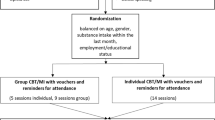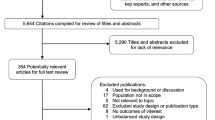Abstract
This is a secondary analysis of data from a randomized trial of dually-focused interventions for nonadherent HIV patients with cocaine use disorders (Ingersoll et al. in Drug Alcohol Depend 116(1–3):177–187, 2011). We examined the relationships among baseline demographic, psychological, psychiatric, and behavioral characteristics and 6-months post-study ART adherence, log viral load (VL), ASI Drug Composite Score, and days using cocaine. We used the SAS GLMSELECT procedure to build multivariate models of each post-study outcome. Post-study ART adherence was related to 2 psychological variables; while logVL was related to 2 drug-related behaviors. ASI Drug Composite score was related to 2 psychiatric disorders, 1 demographic, and 1 psychological variable; in contrast, days using cocaine related to 1 behavioral and 3 psychological variables. Analyses show clear, robust relationships among behavioral, psychological and psychiatric diagnosis factors with post-study ART adherence and cocaine use outcomes. Future ART adherence interventions for cocaine users should consider tailoring to these patient characteristics.
Resumen
Este es un análisis secundario de los datos de un ensayo aleatorio de intervenciones dualmente enfocadas para los pacientes no adherentes VIH con trastornos por consumo de cocaína (Ingersoll et al. 2011). Examinamos las relaciones entre las características demográficas, psicológicos, psiquiátricos y conductuales de base y 6 meses post-estudio de adherencia ART, ingrese la carga viral (VL), ASI Drogas Composite Score, y días de consumir cocaína. Se utilizó el procedimiento SAS GLMSELECT para construir modelos multivariados de cada resultado post-estudio. Post-estudio de adherencia ART se relacionó con 2 variables psicológicas; mientras logVL se relacionó con 2 comportamientos relacionados con las drogas. Puntuación ASI Drogas Composite se relacionó con 2 trastornos psiquiátricos, 1 demográfica y 1 variable psicológica; en contraste, días de consumir cocaína relacionada con 1 conductual y 3 variables psicológicas. Los análisis muestran claros, relaciones sólidas entre los factores de diagnóstico conductuales, psicológicos y psiquiátricos con resultados de cumplimiento ART y de consumo de drogas post-estudio. Las intervenciones de cumplimiento ART futuras de los consumidores de drogas deben considerar la adaptación a estas características de los pacientes.
Similar content being viewed by others

References
Amico KR, Harman JJ, Johnson BT. Efficacy of antiretroviral therapy adherence interventions: A research synthesis of trials, 1996 to 2004. J Acquir Immune Defic Syndr. 2006;41(3):285–97.
Arnsten JH, Li X, Mizuno Y, Knowlton AR, Gourevitch MN, Handley K, et al. Factors associated with antiretroviral therapy adherence and medication errors among HIV-infected injection drug users. J Acquir Immune Defic Syndr. 2007;46(Suppl 2):S64–71.
Bangsberg DR, Acosta EP, Gupta R, Guzman D, Riley ED, Harrigan PR, et al. Adherence-resistance relationships for protease and nonnucleoside reverse transcriptase inhibitors explained by virological fitness. AIDS. 2006;20(2):223–31.
Baum MK, Rafie C, Lai S, Sales S, Page B, Campa A. Crack-cocaine use accelerates HIV disease progression in a cohort of HIV-positive drug users. J Acquir Immune Defic Syndr. 2009;50(1):93–9.
Celentano DD, Galai N, Sethi AK, Shah NG, Strathdee SA, Vlahov D, et al. Time to initiating highly active antiretroviral therapy among HIV-infected injection drug users. AIDS. 2001;15(13):1707–15.
Cook JA, Burke-Miller JK, Cohen MH, Cook RL, Vlahov D, Wilson TE, et al. Crack cocaine, disease progression, and mortality in a multicenter cohort of HIV-1 positive women. AIDS. 2008;22(11):1355–63.
Fisher JD, Amico KR, Fisher WA, Harman JJ. The information-motivation-behavioral skills model of antiretroviral adherence and its applications. Curr HIV/AIDS Rep. 2008;5(4):193–203.
Fogarty L, Roter D, Larson S, Burke J, Gillespie J, Levy R. Patient adherence to HIV medication regimens: a review of published and abstract reports. Patient Educ Couns. 2002;46(2):93–108.
Gardner EM, McLees MP, Steiner JF, del Rio C, Burman WJ. The spectrum of engagement in HIV care and its relevance to test-and-treat strategies for prevention of HIV infection. Clin Infect Dis. 2011;52(6):793–800.
Harzke AJ, Williams ML, Bowen AM. Binge use of crack cocaine and sexual risk behaviors among African-American. AIDS Behav. 2009;13(6):1106–18.
Ickovics JR, Meade CS. Adherence to antiretroviral therapy among patients with HIV: a critical link between behavioral and biomedical sciences. J Acquir Immune Defic Syndr. 2002;31(Suppl 3):S98–102.
Ingersoll K. The impact of psychiatric symptoms, drug use, and medication regimen on non-adherence to HIV treatment. AIDS Care. 2004;16(2):199–211.
Ingersoll KS, Farrell-Carnahan L, Cohen-Filipic J, Heckman CJ, Ceperich SD, Hettema J, et al. A pilot randomized clinical trial of two medication adherence and drug use interventions for HIV+ crack cocaine users. Drug Alcohol Depend. 2011;116(1–3):177–87.
Lucas GM, Gebo KA, Chaisson RE, Moore RD. Longitudinal assessment of the effects of drug and alcohol abuse on HIV-1 treatment outcomes in an urban clinic. AIDS. 2002;16(5):767–74.
Lucas GM, Mullen BA, McCaul ME, Weidle PJ, Hader S, Moore RD. Adherence, drug use, and treatment failure in a methadone-clinic-based program of directly administered antiretroviral therapy. AIDS Patient Care STDs. 2007;21(8):564–74.
Malta M, Magnanini MM, Strathdee SA, Bastos FI. Adherence to antiretroviral therapy among HIV-infected drug users: a meta-analysis. AIDS Behav. 2008;14:731–47.
Malta M, Strathdee SA, Magnanini MM, Bastos FI. Adherence to antiretroviral therapy for human immunodeficiency virus/acquired immune deficiency syndrome among drug users: a systematic review. Addiction. 2008;103(8):1242–57.
McGahan PL, Griffith JA, Parente R, McLellan AT. Addiction severity index, composite score manual. Philadelphia: The University of Pennsylvania/Veterans Administration Center for Studies of Addiction; 1986.
McLellan AT, Luborsky L, Cacciola J, Griffith J, Evans F, Barr HL, et al. New data from the addiction severity index. Reliability and validity in three centers. J Nerv Ment Dis. 1985;173(7):412–23.
Menendez-Arias L. Molecular basis of human immunodeficiency virus drug resistance: an update. Antiviral Res. 2010;85(1):210–31.
Nieuwkerk PT, Oort FJ. Self-reported adherence to antiretroviral therapy for HIV-1 infection and virologic treatment response: a meta-analysis. J Acquir Immune Defic Syndr. 2005;38(4):445–8.
Paredes R, Clotet B. Clinical management of HIV-1 resistance. Antiviral Res. 2010;85(1):245–65.
Rueda S, Park-Wyllie LY, Bayoumi AM, Tynan AM, Antoniou TA, Rourke SB, et al. Patient support and education for promoting adherence to highly active antiretroviral therapy for HIV/AIDS. Cochrane Database Syst Rev. 2006;3:CD001442.
Sandelowski M, Voils CI, Chang Y, Lee EJ. A systematic review comparing antiretroviral adherence descriptive and intervention studies conducted in the USA. AIDS Care. 2009;21(8):953–66.
Sharpe TT, Lee LM, Nakashima AK, Elam-Evans LD, Fleming PL. Crack cocaine use and adherence to antiretroviral treatment among HIV-infected black women. J Community Health. 2004;29(2):117–27.
Sheehan DV, Lecrubier Y, Harnett-Sheehan K, Janavs J, Weiller E, Bonora LI, et al. Reliability and validity of the MINI international neuropsychiatric interview (M.I.N.I.): according to the SCID-P. Eur Psychiatry. 1997;12:232–41.
Sheehan DV, Lecrubier Y, Sheehan KH, Amorim P, Janavs J, Weiller E, et al. The mini-international neuropsychiatric interview (M.I.N.I.): the development and validation of a structured diagnostic psychiatric interview for DSM-IV and ICD-10. J Clin Psychiatry. 1998;59(Suppl 20):22–33 quiz 34–57.
Simoni JM, Frick PA, Huang B. A longitudinal evaluation of a social support model of medication adherence among HIV-positive men and women on antiretroviral therapy. Health Psychol. 2006;25(1):74–81.
Sobell LC, Sobell MB. Timeline follow-back: A technique for assessing self-reported ethanol consumption. In: Litten RZ, Allen J, editors. Measuring alcohol consumption: psychosocial and biological methods. Totowa: Humana Press; 1992. p. 41–72.
Tozzi V, Zaccarelli M, Bonfigli S, Lorenzini P, Liuzzi G, Trotta MP, et al. Drug-class-wide resistance to antiretrovirals in HIV-infected patients failing therapy: prevalence, risk factors and virological outcome. Antivir Ther. 2006;11(5):553–60.
Wang C, Vlahov D, Galai N, Bareta J, Strathdee SA, Nelson KE, et al. Mortality in HIV-seropositive versus -seronegative persons in the era of highly active antiretroviral therapy: implications for when to initiate therapy. J Infect Dis. 2004;190(6):1046–54.
Zolopa AR. The evolution of HIV treatment guidelines: current state-of-the-art of ART. Antiviral Res. 2010;85(1):241–4.
Acknowledgments
This study was funded by NIH/NIDA by grant R01 DA016554.
Author information
Authors and Affiliations
Corresponding author
Ethics declarations
Conflict of interest
The authors declare no conflicts of interest.
Electronic supplementary material
Below is the link to the electronic supplementary material.
Rights and permissions
About this article
Cite this article
Read, G., Ingersoll, K.S. Which Patient Characteristics Among Cocaine Users with HIV Relate to Drug Use and Adherence Outcomes Following a Dual-Focused Intervention?. AIDS Behav 20, 633–645 (2016). https://doi.org/10.1007/s10461-015-1119-6
Published:
Issue Date:
DOI: https://doi.org/10.1007/s10461-015-1119-6



